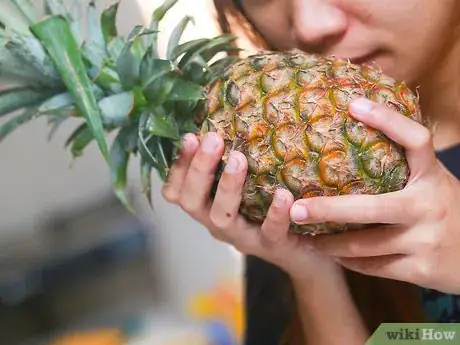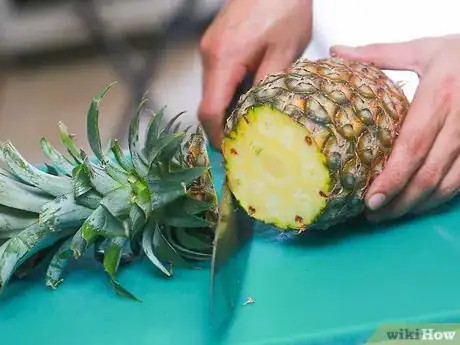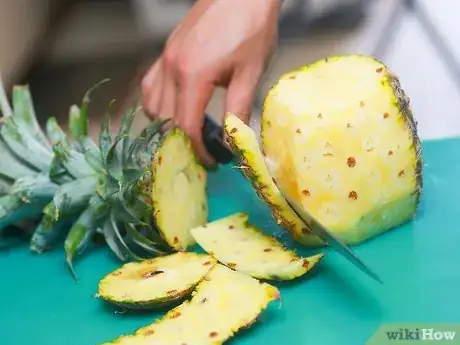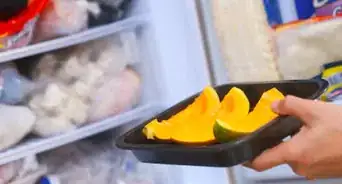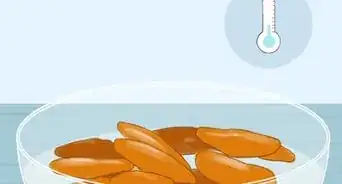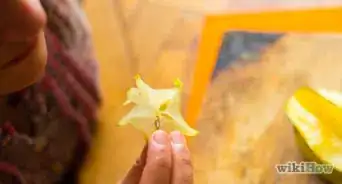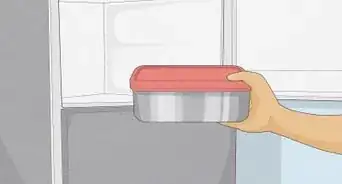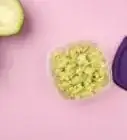This article was co-authored by Ed Kuoha. Ed Kuoha is a Chef and the Owner of Kuoha Culinary based in Aiea, Hawaii. He has more than 20 years of experience in various culinary kitchens and settings such as Morimoto Waikiki, where he received hands-on training from Iron Chef Morimoto. Chef Ed specializes in small catering events and private chef requests. He holds an Associate’s degree from The Culinary Institute of the Pacific at Kapiolani Community College.
There are 8 references cited in this article, which can be found at the bottom of the page.
wikiHow marks an article as reader-approved once it receives enough positive feedback. This article received 20 testimonials and 100% of readers who voted found it helpful, earning it our reader-approved status.
This article has been viewed 610,034 times.
Almost all the pineapple's sweetness shows up in a few days of rapid ripening on the plant. Once picked, the fruit will not become sweeter. On the other hand, these oddballs of the fruit world can sometimes reach ripeness even when the skin is completely green. If you're lucky, your "unripe" pineapple will be sweet and delicious. If not, there are a couple tricks you can use to soften the unripe fruit and make it more pleasant to eat.
Steps
Handling an Unripe Pineapple
-
1Smell to test the ripeness. Most of the usual signs of ripe fruit don't mean much on a pineapple. Sniff the base of the pineapple instead: a strong scent means the pineapple is ripe. If you can barely smell it, it's probably not. Cold pineapples never smell strong, so leave them at room temperature for a while before you try this.
- A yellow-skinned pineapple is a safer choice than a green one, but this isn't a perfect test. Some pineapples are ripe when completely green.[1] Others have golden or red skins, but are still hard and unpleasant to eat.
-
2Expect the pineapple to soften, but not sweeten. Pineapples do not ripen properly after they are picked.[2] On your kitchen counter, the pineapple will become softer and juicier, but it will not become sweet. All of a pineapple's sugar comes from the starches in the stem of the plant. Once that source is cut off, the pineapple cannot make more sugar on its own.[3]
- Green pineapples will usually change color as well.
- It's possible that the pineapple will become even more acidic if stored too long.
Advertisement -
3Prop it upside down (optional). If the pineapple does have a little starch left to convert to sugar, this will be in the base of the fruit. In theory, the sugar might spread better if you keep the pineapple upside down. In practice, the effect is hard to notice, but it might be worth a try.[4]
- The skin color also travels from the base upward, although this isn't relevant to the ripeness after picking.
- If it's difficult to prop up your pineapple, twist off the top and place the exposed end on a damp paper towel.[5]
-
4Leave it at room temperature. The pineapple should soften within a day or two. Most pineapples will quickly ferment if stored for much longer than this.[6]
- If the pineapple was picked unripe, it will still be unpleasant to eat. Keep reading to find out how to improve the taste of an unripe pineapple.
- If you're not ready to eat the pineapple yet, move it to the fridge for another 2–4 days.
Eating Unripe Pineapple
-
1Be cautious with unripe pineapples. Very young, unripe pineapples may be toxic. Eating them can irritate your throat and have a severe laxative effect.[7] That said, most pineapples sold commercially should be at least partially ripe, even if they look green.
- Even ripe pineapple can hurt your mouth or cause it to bleed. The techniques below will help prevent this as well.
-
2Cut the pineapple. Cut off the stem and crown of the pineapple. Then stand the rest flat on a cutting board. Cut off the rind and eyes. You need to cut deep enough to clear the eyes of the pineapple, but not too deep to avoid wasting. Then slice into rounds or chunks.
-
3Grill the pineapple. Grilling will caramelize the sugars in the pineapple, adding flavor to a bland, partially unripe fruit.[8] The heat will also neutralize bromelain, the enzyme that can cause pain and bleeding in your mouth.
-
4Heat pineapple slices in the oven. This has the same results as grilling: a delicious, sweet pineapple. If the pineapple is quite tart and unripe, sprinkle brown sugar over it before heating.
-
5Simmer the pineapple. Although this won't caramelize the sugar, simmering will neutralize all of the bromelain. Try this if raw pineapple hurts your mouth:
- Add pineapple chunks to a saucepan along with all juice collected while cutting.
- Add enough water to cover.
- Bring to a boil over medium-high heat.
- Reduce to a simmer and heat for 10 minutes.
- Drain and let cool.
-
6Sprinkle sugar over cut pineapple. If your pineapple doesn't taste sweet, sprinkle the chunks or rounds with sugar. Eat right away, or store covered in the fridge.
Community Q&A
-
QuestionHow do you know when a pineapple is ready?
 Community AnswerThe bottom will smell like a pineapple. If it doesn't smell like anything, it isn't ripe.
Community AnswerThe bottom will smell like a pineapple. If it doesn't smell like anything, it isn't ripe. -
QuestionThe bottom of my pineapple is rotten. Should I throw the whole pineapple away?
 Community AnswerWhen my pineapples go bad on the bottom, I usually cut off that piece and see if the rest is good enough to eat. If it is, eat it right away; if you don't, the rest of it will go bad very quickly.
Community AnswerWhen my pineapples go bad on the bottom, I usually cut off that piece and see if the rest is good enough to eat. If it is, eat it right away; if you don't, the rest of it will go bad very quickly. -
QuestionWhat do I do with a cut pineapple that is not ripe?
 Anna JohnsonCommunity AnswerYou can try placing it in an open container that won't leak juice (like a plastic container) and putting it in a paper bag in the fridge with an apple. This should help it ripen faster. You could also try grilling it.
Anna JohnsonCommunity AnswerYou can try placing it in an open container that won't leak juice (like a plastic container) and putting it in a paper bag in the fridge with an apple. This should help it ripen faster. You could also try grilling it.
Warnings
References
- ↑ https://www.hort.purdue.edu/newcrop/morton/pineapple.html
- ↑ https://postharvest.ucdavis.edu/Commodity_Resources/Fact_Sheets/Datastores/Fruit_English/?uid=50&ds=798
- ↑ http://www.ctahr.hawaii.edu/oc/freepubs/pdf/B-028.pdf
- ↑ https://www.youtube.com/watch?v=NIi4-6FN5pM
- ↑ https://www.youtube.com/watch?v=fBz8Fnma9pE
- ↑ http://www.nytimes.com/1982/04/21/garden/a-guide-to-choosing-a-ripe-pineapple.html
- ↑ https://www.hort.purdue.edu/newcrop/morton/pineapple.html
- ↑ http://www.kitchenriffs.com/2013/08/grilled-pineapple.html
- ↑ https://postharvest.ucdavis.edu/Commodity_Resources/Fact_Sheets/Datastores/Fruit_English/?uid=50&ds=798
About This Article
If you have a pineapple that you think may be unripe, give it a sniff. A pineapple may be ripe even when it’s green, so smelling it is a more reliable way to tell than looking at it. If the pineapple smells sweet, it’s probably ripe. But if it has very little smell, it’s likely to be unripe. To encourage the pineapple to ripen and soften, leave it on your counter for 1 to 2 days at room temperature. You can also try storing it upside down, which may help the natural sugars in the pineapple spread throughout the fruit and sweeten it. Unfortunately, if the pineapple was unripe before it was picked, it probably won’t get much sweeter. However, it should soften a bit. If you’re not ready to eat the pineapple yet after leaving it out for a day or two, keep it in the fridge for another 2-4 days so it doesn’t spoil. Once you’re ready to eat the pineapple, cut or twist off the stem and use a sharp knife to slice away the rind and eyes. Cut the fruit inside into rounds or chunks. If you want, you can bring out the natural sweetness of the pineapple by cooking it a little. Grilling or baking pineapple will caramelize the sugars. Another option is to simmer the pineapple. This won’t make it any sweeter, but it will neutralize some of the bromelain, a harsh natural compound in unripe pineapple that can irritate your mouth and stomach. For extra sweetness, sprinkle sugar over the pineapple pieces before you eat them. Just be cautious about eating a pineapple that is very underripe, it can irritate your throat and cause an upset stomach or diarrhea.
